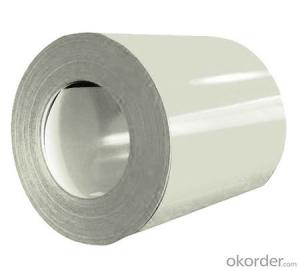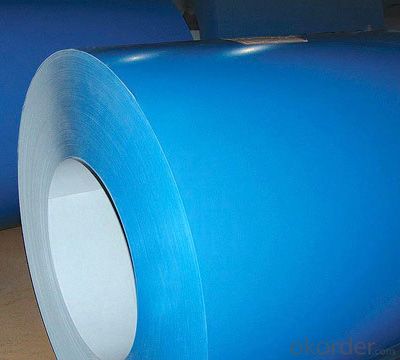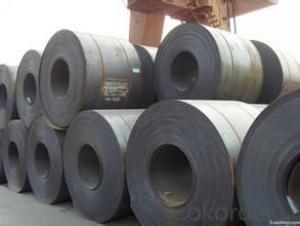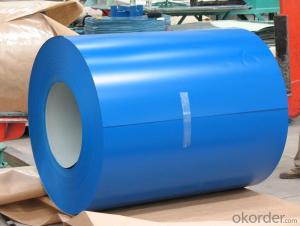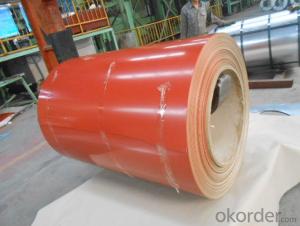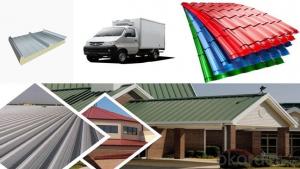Prepainted Galvanized Steel Coils Good Quality
- Loading Port:
- China main port
- Payment Terms:
- TT OR LC
- Min Order Qty:
- 50 m.t.
- Supply Capability:
- 10000 m.t./month
OKorder Service Pledge
OKorder Financial Service
You Might Also Like
Prepainted Galvanized Steel Coils Good Quality
1. Structure of Prepainted Galvanized steel Coil :
•Prepainted galvanized steel qualified with excellent decorative ,formability ,corrosion resistance ,coating adhesion ,can keep for a long time as well as maintain fresh color .For color coated steel sheet can obtain good economic benefit by steel belt wood ,efficient in construction and save energy ,prevent pollution etc. Which is an ideal material for manufacturing board.
2.Main Features of Prepainted Galvanized steel Coil:
• Excellent process capability
• Smooth and flat surface
• Workability, durability
• High strength
3.Prepainted Galvanized steel Coil Images

4.Prepainted Galvanized steel Coil Specification
Standard: ASTM, GB,JIS,JIS G3302 ASTM 755 EN10169
Grade: DX51D CGCC CS
Thickness: 0.18mm~1.2mm,
Width: 600-1250mm
Coil weight:3-12 MT
Coil ID:508/610mm
5.FAQ of Prepainted Galvanized steel Coi
We have organized several common questions for our clients,may help you sincerely:
1.How do you control your quality
We have established the international advanced quality management system,every link from raw material to final product we have strict quality test;We resolutely put an end to unqualified products flowing into the market. At the same time, we will provide necessary follow-up service assurance.
2.How long we will receive the goods ?
After receiving your deposit or workable lc ,our normal shipment date is 15-20days,and it takes around 28 days to reach your port of destination. But is up to different destination
- Q: The stainless steel drinking fountain had a little acid on it and rusted. I need to restore it. Is this possible?
- Stainless steel doesn't rust, whatever acid you got on it was some pretty bad stuff to make a reaction like that, you can try sanding down past the reaction point and polish it out but that's about it, that or it wasn't stainless to begin with. if its brushed chrome to simulate stainless it would have to be replated, not cheap. and probably not worth it
- Q: who are the 7 best steel guitar players ever?
- 1. Buddy Emmons 2. Jimmy Day 3. Tom Brumley 4. Ralph Mooney 5. Shot Jackson 6. Jerry Byrd 7. Speedy West
- Q: I am wondering if i can use my western guitar as a kind of steel-guitar, read something about it on Wikipedia.
- Musical style speaks volumes while it includes this concern. people who % severe quantity would be unhappy with unamplified nylon string guitars. From my attitude, the common distinction between metallic and nylon is this: metallic strings ring and nylon strings resonate. the quantity produced by employing metallic is frequently plenty greater suitable than nylon yet, to my way of thinking, the sound resonance produced by employing the wood of your guitar is largely masked by employing metallic strings. in case you have a decently made guitar (frequently, around 1000 money and up), the sound interaction between the wood and the strings in a nylon guitar is magical around the completed frequency selection. With a metallic string guitar, the sound produced by employing the vibrating string overpowers the wood resonance in any respect yet low frequencies. in my view, i will take a nylon string guitar any day for the sensitivity gained from the interaction between wood and vibrating string.
- Q: my step father bought a big steel drum grill it has steel sheets (very thin) that go inbetween the flame and the food (closer to the flame) with that there the food will not cook, it does not get hot enough????? please help... what should we do
- This type of grill cooks like an oven You have to keep the lid shut until the proper temp. is reached. Then place you meats and stuff on the grill and close the lid. Open the lid infrequently to keep the heat in. If its charcoal make sure you use enough charcoal the first time so you don't have to add any while you food is cooking.
- Q: What are the dimensions of steel coils used in the structural component industry?
- The dimensions of steel coils utilized in the structural component sector are subject to variation, contingent upon the particular application and specifications. Nevertheless, standard dimensions for steel coils in this industry encompass a width that ranges between 600mm and 2000mm, as well as a thickness that spans from 0.25mm to 10mm. The weight of these coils may also differ, typically ranging from a few kilograms to numerous tonnes. Furthermore, the length of the steel coils can be customized to fulfill the specific demands of the structural component industry, with commonplace lengths including 2000mm, 2500mm, and 3000mm. It is vital to acknowledge that these dimensions are not exhaustive and are susceptible to variation based on the specific product and manufacturer.
- Q: Can steel coils be used in the production of consumer goods?
- Yes, steel coils can be used in the production of consumer goods. Steel coils are typically used as raw material in various industries, including automotive, construction, and manufacturing. In the consumer goods industry, steel coils can be used to produce a wide range of products such as appliances, furniture, tools, packaging materials, and even consumer electronics. The inherent strength, durability, and versatility of steel make it an ideal choice for manufacturing consumer goods that require stability, safety, and longevity. Additionally, steel coils can be easily shaped, molded, and formed into different components or parts, allowing for customization and design flexibility in the production process. Therefore, steel coils play a crucial role in the production of consumer goods and are widely used across various sectors.
- Q: What is the process of galvanizing steel coils?
- The process of galvanizing steel coils involves immersing them in a bath of molten zinc to create a protective coating. The coils are first cleaned and then passed through a series of chemical baths to prepare the surface for galvanization. Afterward, they are dipped into the molten zinc, which bonds to the steel to form a corrosion-resistant layer. Once coated, the coils are cooled, inspected, and prepared for shipment or further processing.
- Q: How are steel coils weighed?
- Steel coils are usually weighed using industrial scales or weighing machines. These scales are specifically designed to handle the heavy weight of steel coils and provide accurate measurements. The coils are placed on the scale, and the weight is determined based on the pressure exerted on the scale's sensors.
- Q: I love the design! It looks great, is safe, and you can see through it just fine on camera. Do you like it?BQ: Old Blue WWF Steel Cage or the newer fence type steel cage?
- yes it is better now
- Q: Can steel coils be used in the production of automotive parts?
- Indeed, the utilization of steel coils is possible in the manufacturing of automotive parts. Various automotive components like body panels, frames, chassis, suspension parts, and engine parts frequently incorporate steel coils within their production process. To achieve the desired shape of these automotive parts, the steel coils typically undergo a range of techniques including cutting, stamping, bending, and welding. The strength, durability, and corrosion resistance of steel make it a favored material for automotive parts. Additionally, steel coils are accessible in different grades and thicknesses, enabling manufacturers to customize the material properties to fulfill specific requirements for diverse automotive applications. Collectively, steel coils play a crucial role in the fabrication of automotive parts, thereby contributing significantly to the performance, safety, and durability of vehicles.
Send your message to us
Prepainted Galvanized Steel Coils Good Quality
- Loading Port:
- China main port
- Payment Terms:
- TT OR LC
- Min Order Qty:
- 50 m.t.
- Supply Capability:
- 10000 m.t./month
OKorder Service Pledge
OKorder Financial Service
Similar products
Hot products
Hot Searches
Related keywords
